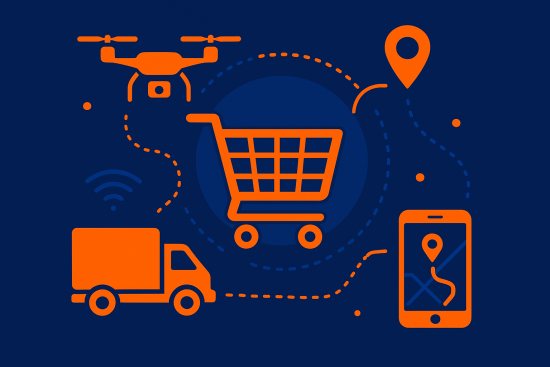
Table of Contents
The rise of social commerce has transformed the way companies interact with their customers and conduct online transactions. This revolutionary phenomenon merges social media and e-commerce, providing a dynamic platform for brands to reach their audiences directly through immersive shopping experiences. In this article we will explore what social commerce is, the benefits it presents for businesses and how you can take your first steps into this exciting world of digital opportunities.
What is Social Commerce?
Social commerce represents an innovative fusion of social media and e-commerce, redefining the online shopping experience. It involves integrating shopping functions directly into social media platforms, allowing users to browse products, transact and share their shopping experiences, all within the same digital environment. This revolutionary approach not only connects brands with their audiences more directly, but also offers consumers a more interactive and personalized shopping experience. Discover how social commerce is transforming the way we interact with products and services through our favorite social platforms.
Benefits of Social Commerce for Companies
Social commerce offers a number of key benefits for companies looking to boost their online sales strategies:
Increased Reach and Visibility: By integrating shopping functions directly into social networks, companies can extend their reach and increase the visibility of their products, reaching a wider audience of potential consumers.
Direct Interaction with Customers: Social commerce facilitates direct interaction between brands and their customers. Companies can answer questions, receive feedback and build stronger relationships with their audience through social platforms.
3. Personalized Shopping Experience: By knowing the behaviors and preferences of users on social networks, companies can offer more personalized shopping experiences, recommending products tailored to the individual interests of each customer.
4. Impulse Sales: The visual nature of social media creates opportunities to drive impulse sales. Users can instantly discover and purchase products while browsing their feed.
5. Facilitates Creative Content Integration: Social commerce allows brands to integrate creative content, such as videos and photos, directly into the buying process, providing customers with a more engaging and exciting experience.
6. Real-Time Data and Analytics: Social commerce platforms provide real-time data on customer behavior, allowing companies to perform detailed analysis and adjust their strategies quickly and effectively.
How to Get Started in Social Commerce
Here are some key steps to get started in social commerce:
Select the Right Platforms: Identify the social media platforms that best align with your target audience. Facebook, Instagram and Pinterest are popular choices, but the choice will depend on your industry and type of products.
2. Set up an Online Store: On most social media platforms, you can set up an online store directly. Fill in your business information, add products and make sure the store reflects your brand identity.
3. Optimize for the Mobile Experience: Since many social media purchases are made from mobile devices, it is essential that your online store is optimized for a smooth and efficient mobile experience.
4. Create Attractive Content: Generate attractive visual content that highlights your products. High quality images, short videos and clear descriptions are essential to capture users' attention.
5. Implement Direct Purchase Functions: Make it easy for customers to buy by integrating direct purchase functions in your publications and profiles. Make sure the checkout process is simple and secure.
6. Promote and Advertise: Use the advertising tools available on social media platforms to promote your products. Segment your audience and adjust your advertising strategy according to the results obtained.
7. Analyze and Adjust: Constantly monitor the performance of your online store. Analyze data, observe buying trends and adjust your strategy according to customer feedback.
Effective Strategies for Social Commerce
Success in social commerce lies in the implementation of effective strategies that connect with the audience and generate interaction. Here are some strategies you can incorporate:
- Influencer Marketing: Collaborate with relevant influencers in your industry to expand your brand's reach. Influencers can present your products in an authentic and persuasive way.
- User Generated Content: Encourage your customers to share their experiences with your products. Post photos and reviews from satisfied customers, creating authentic and trustworthy content.
- Exclusive Offers and Discounts: Encourage participation by offering exclusive offers and discounts to your social media followers. This not only drives sales, but also strengthens customer loyalty.
- Interactive Posts: Create interactive posts, such as polls, contests or Q&A. Direct interaction with customers builds an engaged community around your brand.
- Creative Use of Hashtags: Design unique hashtags for your campaigns and products. Encourage your followers to use them, making it easier to follow the conversation and create a distinctive brand identity.
- Augmented Reality (AR) implementation: Explore the possibility of integrating AR features to allow customers to "try" products virtually before they buy. This adds an exciting dimension to the shopping experience.
- Strategic Collaborations: Collaborate with other brands or complementary companies to expand your reach and offer customers a unique value proposition.
- Real-Time Data Analysis: Use analytical tools to monitor the performance of your strategies in real time. Adjust your tactics based on the data collected to maximize effectiveness.
Tools and Resources
Successful execution of social commerce strategies benefits from specialized tools and resources. Here are some essential platforms and resources that can boost your social commerce presence:
- Buffer: This tool allows you to schedule publications in various social networks, facilitating the management and consistency of your content.
- Hootsuite: It offers a comprehensive platform for social media management, allowing you to schedule posts, track mentions and analyze performance.
- Canva: Ideal for the creation of attractive visual content. You can easily design graphics, banners and optimized publications for each platform.
- Shopify: If you are looking for a complete e-commerce solution, Shopify is an outstanding choice. It offers tools for creating online stores and integration with social networks.
- Google Analytics: For a comprehensive analysis of activity on your website and social networks. Gain valuable insights into user behavior and campaign performance.
- Later: Specializing in Instagram, Later simplifies post scheduling, content management and metrics tracking for this social network.
- Linktree: Linktree allows you to add several links in your biography, directing users to different pages, products or promotions.
- Facebook Ads ManagerIf you plan to use social media advertising, this tool gives you full control over your Facebook and Instagram campaigns.
Social commerce has evolved to become a driving force in the world of digital marketing. With the ability to connect directly with audiences, build active communities and boost sales, it is essential for any business looking to stand out in the digital age.
Stay informed and updated with our blog ClickPanda. Here, we not only boost your digital presence, but we encourage you to explore a world of possibilities to connect with your audience and increase your online sales. Are you ready to move forward, elevate your online presence to higher levels and discover a world full of benefits? Immerse yourself in a unique experience in social commerce with ClickPanda!








